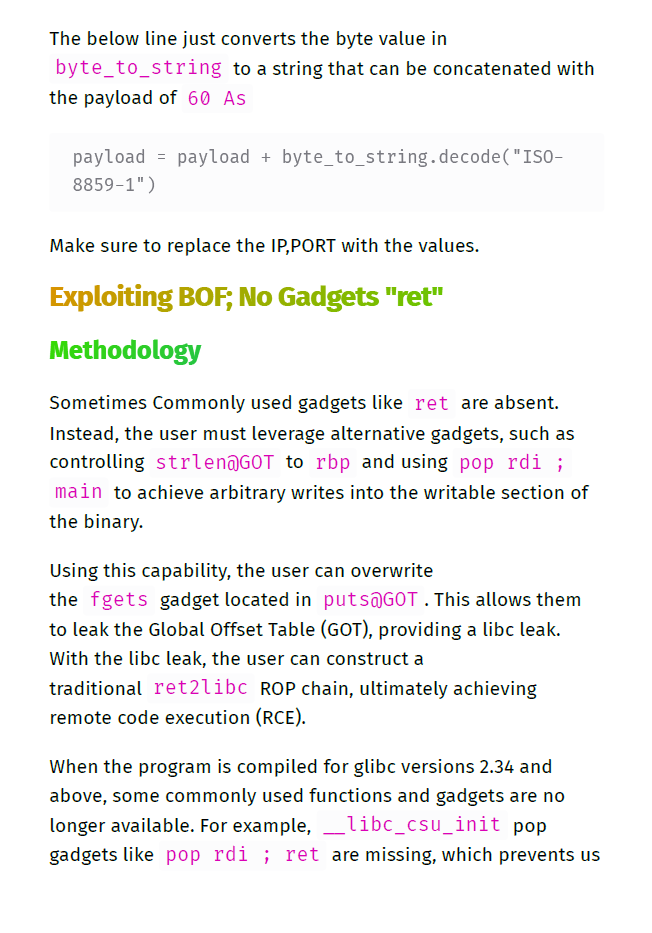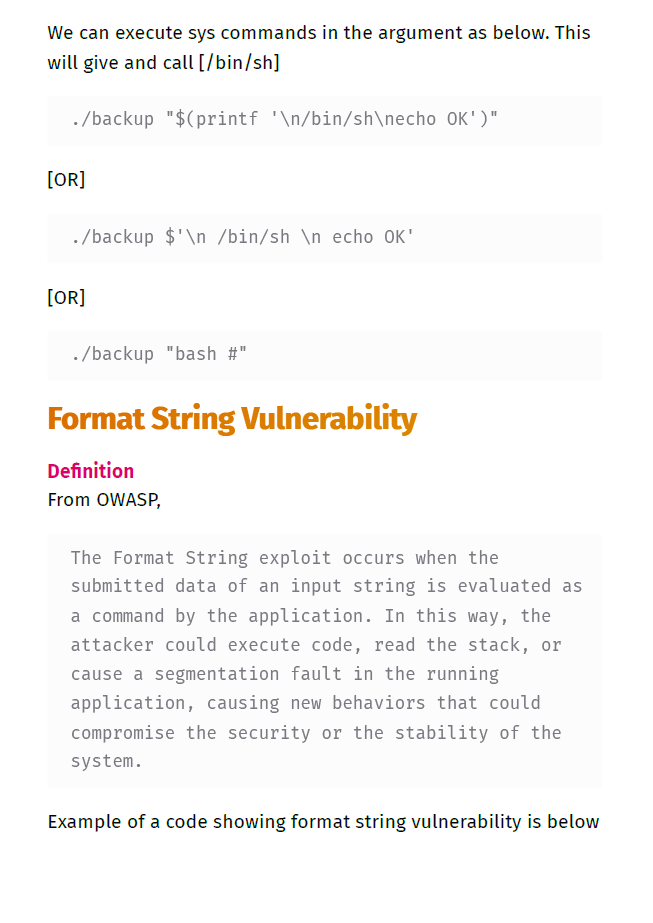This study guide comprehensively covers binary exploitation techniques, starting from assembly basics to advanced exploitation methods like Return-Oriented Programming (ROP) and ret2libc. It provides hands-on examples of exploiting stack and heap overflows, bypassing security protections (NX, ASLR, PIE), and using tools like GDB, pwndbg, and Ghidra.
A step-by-step methodology is presented for both basic and advanced attacks, with Python scripting to automate exploits. The document emphasizes understanding memory structures, stack layouts, and leveraging system functions for exploitation, giving a practical pathway from theory to real-world applications.
Why will you need a notes system?
You could be actively working as Malware analyst or a Penetration Tester or you could be preparing and studying for a certification exam such as OSCP. In both cases, a set of notes maintained in your repository where you can search for commands, concepts or use cases that could aid you in the task you are performing is necessary for a productive studying and/or working.
Who Are These Notes For?
This guide is designed for:
- Cybersecurity students and professionals preparing for certifications like OSCP, OSEP, or eJPT.
- Penetration testers and red teamers seeking to enhance their exploitation skills.
- CTF (Capture The Flag) participants focusing on binary exploitation challenges.
- Individuals interested in reverse engineering and understanding low-level software vulnerabilities.
The Buffer Overflow & Binary Exploitation Techniques Study Notes Catalog
This document is an extensive guide to buffer overflows (BOF) and binary exploitation, particularly focusing on x86-64 architectures, C programming vulnerabilities, and modern exploitation techniques. It covers theoretical knowledge, practical exploitation methods, and tools used in Capture The Flag (CTF) challenges and cybersecurity analysis.
Its an 138-Page PDF book contains various methods and techniques to exploit binaries using various methods such as buffer overflow with protections enabled or without in addition to other techniques such as format string vulnerability.
Table of Contents:
– Buffer Overflow Basics
– Buffer Overflow Exploitation Techniques
– Process Hollowing
– Process Injection
– DLL Injection
Format: PDF
Page Count: 184


Testimonials (LinkedIn)
How to buy the book?
You can buy the booklet directly by clicking on the button below
What about the notes updates?
if you have been watching my YouTube Channel, you definitely know that those who subscribe to the second tier of my channel membership they instantly get access to a vast catalog of cybersecurity, penetration testing, digital marketing, system administration and data analytics notes catalog for 10$ along with the ability to receive all notes updates as long as they are subscribed so what does that mean?
This means if you want to stay up to date with the changes and updates to the notes and get access to other categories, I encourage to join the channel membership second tier instead. However, if you are fine with downloading the current version of this section of the notes then you can buy this booklet instead for a one-time payment.
Will the prices of this book change in the future?
Once another version of this book is released, which it will, the price will slightly change as the booklet will include more contents, notes and illustrations.
Free Binary Exploitation & Bufferover Flow Training
Checkout the playlist below on my YouTube channel for Free Binary Exploitation & Bufferover Flow Training
FAQ
What topics are covered in the guide?
The guide delves into various aspects of buffer overflow exploitation, including:
- Identifying and analyzing buffer overflow vulnerabilities.
- Crafting payloads to exploit these vulnerabilities.
- Bypassing common security mechanisms like NX (No eXecute) and ASLR (Address Space Layout Randomization).
- Utilizing tools such as GDB and Radare2 for debugging and analysis.
- Implementing Return-Oriented Programming (ROP) chains
Additionally, the guide references practical exercises and challenges, such as those from HackTheBox, to reinforce the concepts discussed.
Does the guide include practical examples?
Absolutely. The guide incorporates real-world examples and walkthroughs, including exercises from platforms like HackTheBox. These practical scenarios help readers understand how to apply buffer overflow techniques in controlled environments, reinforcing the theoretical knowledge presented.
What prerequisites are recommended before using this guide?
To fully benefit from the guide, readers should have:
- A basic understanding of programming concepts, particularly in C or C++.
- Familiarity with Linux command-line operations.
- An introductory knowledge of assembly language and system architecture.
- Experience with debugging tools like GDB or Radare2 is advantageous but not mandatory.
Does the guide address modern security protections?
Yes, the guide discusses techniques to bypass or mitigate modern security mechanisms, including:
- NX (No eXecute) bit protections.
- ASLR (Address Space Layout Randomization).
- Stack canaries and other compiler-level protections.
It provides insights into how these protections work and strategies to circumvent them during exploitation.
What tools are recommended for following along with the guide?
The guide suggests using tools such as:
- GDB (GNU Debugger) for analyzing and debugging binaries.
- Radare2 for reverse engineering and binary analysis.
- Python for scripting and automating exploit development.
- Obsidian for organizing notes and markup files provided with the guide
These tools are integral to practicing the techniques discussed and are commonly used in the cybersecurity community.

